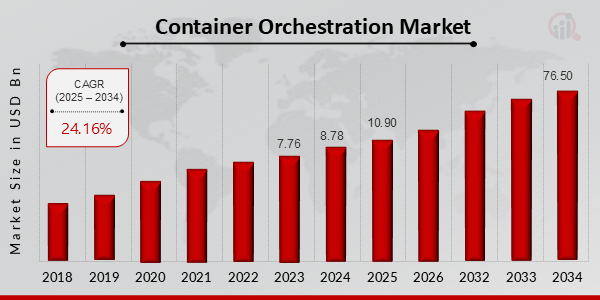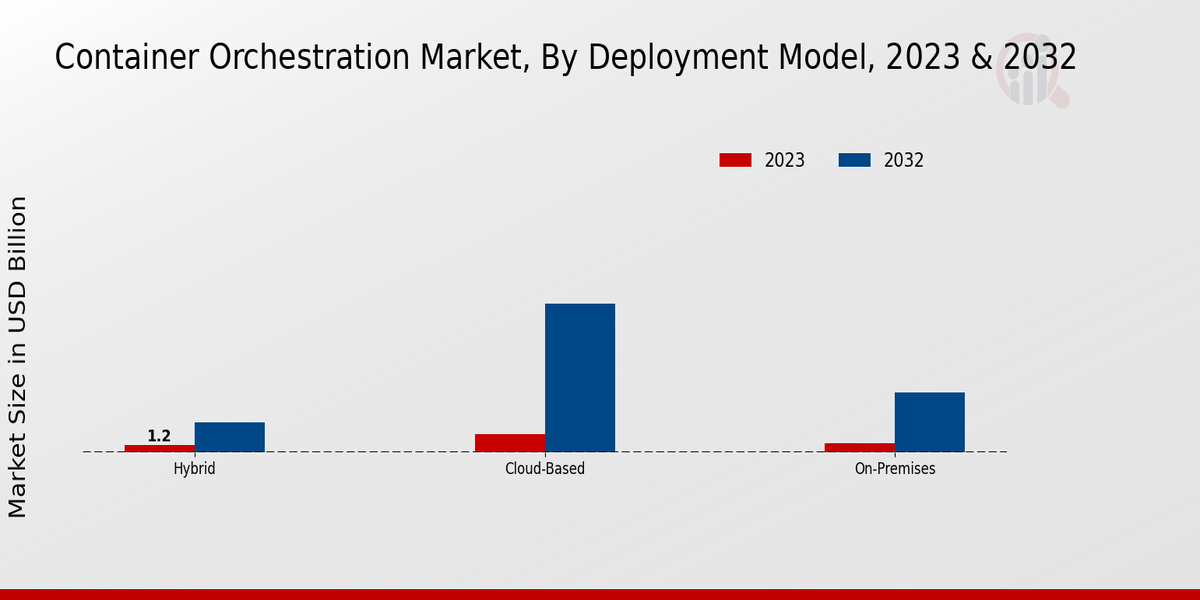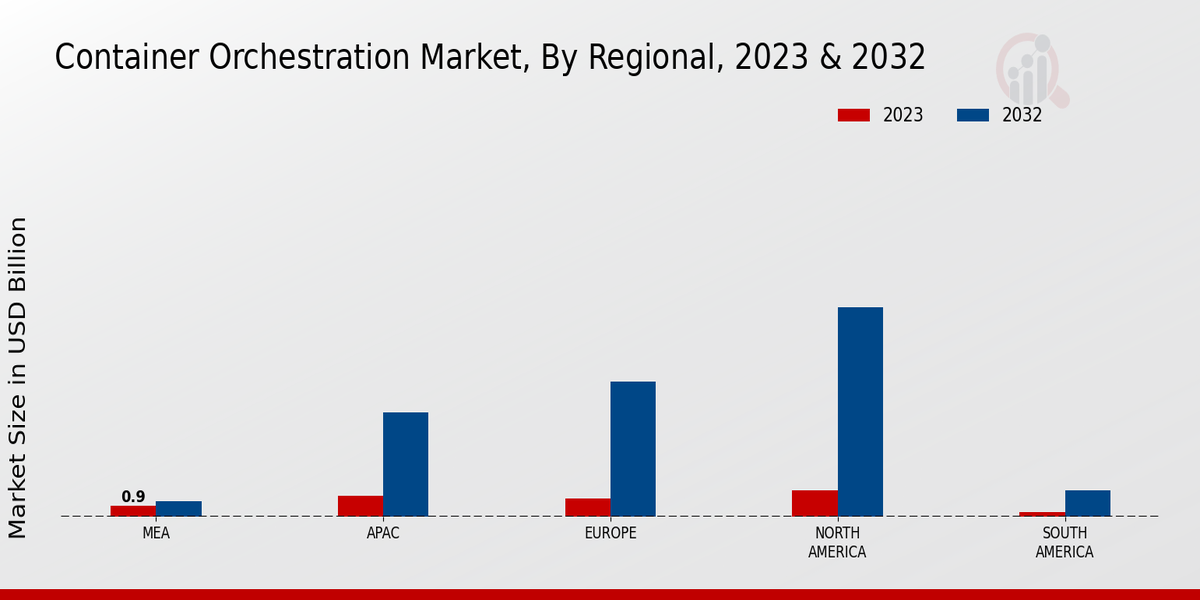Container Orchestration Market Overview
Container Orchestration Market is projected to grow from USD 10.90 Billion in 2025 to USD 76.50 Billion by 2034, exhibiting a compound annual growth rate (CAGR) of 24.16% during the forecast period (2025 - 2034).
Additionally, the market size for Container Orchestration Market was valued at USD 8.78 billion in 2024.
Key Container Orchestration Market Trends Highlighted
The global container orchestration market is experiencing significant growth driven by the increasing demand for efficient application management and orchestration in cloud environments. As more organizations shift towards microservices architectures, the need for container orchestration solutions that automate the deployment, scaling, and management of containerized applications has become paramount. Key market drivers include the rapid adoption of DevOps practices, which emphasize collaboration and automation, thereby increasing the reliance on containerized environments. Additionally, the rising trend of multi-cloud strategies is fueling the need for robust orchestration tools that can seamlessly manage containers across diverse cloud ecosystems.
Opportunities in this evolving landscape are abundant, especially for organizations offering innovative and scalable orchestration solutions. As enterprises continue to embrace cloud-native strategies, there is a growing need for advanced features like auto-scaling, load balancing, and service discovery, which can be leveraged for market differentiation. The integration of artificial intelligence and machine learning within orchestration platforms presents further avenues for development, enabling smarter resource allocation and improved operational efficiency.
In recent times, notable trends include a shift towards hybrid cloud models, where organizations leverage both on-premises and cloud resources, thus necessitating orchestration tools that can operate in a fluid hybrid environment.
The emphasis on security in container management is also becoming more pronounced as organizations seek to address vulnerabilities associated with containerized applications. Such trends highlight an increasing recognition of the importance of container orchestration in ensuring business continuity, operational resilience, and agile delivery of services in a competitive digital landscape.
Figure 1: Container Orchestration Market size 2025-2034

Source: Primary Research, Secondary Research, Market Research Future Database and Analyst Review
Container Orchestration Market Drivers
Increasing Demand for Microservices Architecture
The growing trend toward microservices architecture is one of the most significant drivers of growth in the global container orchestration market. In recent years, businesses have been moving away from monolithic application designs to more modular, service-oriented architectures that allow for greater flexibility and scalability. Microservices enable organizations to deploy, manage, and scale their applications more efficiently, allowing teams to work on different components independently. This shift is driven by the need for continuous integration and delivery (CI/CD) practices, which allow for faster development cycles and quicker deployments.
Moreover, as organizations increasingly embrace cloud-native technologies, they find that container orchestration tools are essential for managing the complex environments that microservices create. These tools facilitate automated deployment, scaling, and management of containers, making them indispensable for businesses aiming to achieve operational efficiency and agility. This trend is likely to continue as more companies adopt a microservices architecture, further fueling the growth of the global container orchestration market.
Rising Adoption of Cloud Computing
The accelerating adoption of cloud computing solutions is significantly driving the global container orchestration market. Organizations are increasingly migrating their workloads to the cloud to take advantage of its scalability, cost-efficiency, and flexibility. As cloud infrastructure becomes the foundation for modern IT operations, containerization has gained traction as a preferred method for deploying and managing applications in these environments.
Container orchestration platforms provide robust management capabilities that are crucial for handling containerized applications in cloud ecosystems, further enhancing their market attractiveness. This widespread shift towards cloud-based services necessitates efficient tools for monitoring and managing applications, which container orchestration solutions are uniquely able to provide.
Need for Improving Application Reliability and Performance
Improvements in application reliability and performance are key drivers for the global container orchestration market. Organizations are under constant pressure to enhance the performance of their applications while ensuring high availability. Container orchestration enables automated management of applications across different environments, providing the necessary tools for scale, resource optimization, and automated recovery from failures.
By effectively managing containerized workloads, businesses can minimize downtime and ensure that their applications run smoothly. This not only enhances user experience but also improves overall business operations, making container orchestration solutions essential for organizations aiming to achieve higher reliability and performance standards.
Container Orchestration Market Segment Insights
Container Orchestration Market Deployment Model Insights
The global container orchestration market is experiencing significant growth across various deployment models, highlighting an evolving landscape that reflects technological advancements and changing business needs. Within the deployment model, the Cloud-Based approach dominates the market, valued at 3.0 USD billion in 2023 and projected to rise significantly to 25.0 USD billion by 2032. This substantial growth can be attributed to the rising adoption of cloud computing and the increasing demand for scalable and agile infrastructures that cloud-based solutions provide.
Meanwhile, the On-Premises deployment model holds a noteworthy position, valued at 1.5 USD billion in 2023 and expected to reach 10.0 USD billion by 2032. This model is significant as it caters to organizations with specific regulatory and security requirements, allowing them to maintain control over their data and applications. The Hybrid model, meanwhile, accounted for 1.2 USD billion in 2023 and is projected to grow to 5.0 USD billion by 2032. The growing trend of integrating both on-premises and cloud resources gives businesses the flexibility they need to optimize their operations while leveraging the benefits of both environments.
The significant growth across these deployment models indicates a shift in how organizations approach infrastructure management, showcasing a preference for solutions that allow for improved resource allocation and enhanced operational efficiencies. The emergence of advanced container orchestration tools that simplify deployment processes and enhance scalability directly contributes to the rising global container orchestration market revenue.
Additionally, factors such as the increasing focus on digital transformation, operational cost reduction, and the need for improved application management drive market growth. However, organizations also face challenges such as security concerns and the need for specialized skills in container orchestration technologies, which can hinder full deployment potential. Understanding these dynamics within the global container orchestration market segmentation is crucial for stakeholders looking to optimize their investments in container orchestration strategies.

Source: Primary Research, Secondary Research, Market Research Future Database and Analyst Review
Container Orchestration Market Service Model Insights
The Service Model segment plays a critical role in this expansion, as it encompasses innovative solutions like Container as a Service (CaaS), Managed Kubernetes, and Self-Managed Kubernetes, which address diverse operational needs. CaaS is gaining traction for its ease of use, allowing businesses to utilize container technology without the complexities of infrastructure management. Meanwhile, Managed Kubernetes has become essential for organizations seeking hassle-free orchestration while maintaining control over their applications, making it a significant choice among enterprises. Self-managed Kubernetes caters to firms with the expertise to manage their own clusters, offering flexibility and customization.
The overall Container Orchestration Market segmentation demonstrates a clear trend toward automation and cloud-native architectures, driving efficiency and scalability in application deployment. The market growth is further supported by the rising adoption of DevOps practices and concerns regarding resource optimization, leading to heightened investments in container orchestration solutions.
Container Orchestration Market Orchestration Tool Type Insights
The Orchestration Tool Type within this market encompasses various solutions that streamline the management and deployment of containers, including prominent tools like Kubernetes, Mesos, Docker Swarm, and Amazon ECS. Kubernetes, in particular, dominates the landscape, favored for its robust features and active community support, making it the go-to choice for enterprises.
Mesos provides flexibility and efficiency in managing resources across large clusters, while Docker Swarm offers simplicity in orchestration for those already utilizing Docker. Amazon ECS is significant for organizations leveraging AWS, facilitating seamless integration with other AWS services. The combination of these tools showcases the diverse approaches to container orchestration, each addressing specific industry needs, further stimulating the overall market growth. With such advancements and increasing adoption of containerization, the importance of understanding the global container orchestration market data and its segmentation becomes crucial for stakeholders looking to capitalize on the expanding opportunities.
Container Orchestration Market End User Industry Insights
Various sectors such as IT and Telecommunications play a pivotal role, leveraging container orchestration to enhance operational efficiency and resource management. Healthcare, with its increasing reliance on digital solutions, also emphasizes the need for scalable and reliable systems, making it essential for the adoption of this technology. The Media and Entertainment industry utilizes container orchestration to streamline content delivery, enhancing user experience through efficient cloud management.
Additionally, the Retail sector is witnessing a surge in demand for agile and scalable solutions to accommodate changing consumer behavior, emphasizing the importance of container orchestration in real-time inventory management and customer engagement. The Manufacturing industry, focusing on IoT implementations, benefits from container orchestration by facilitating better data processing and analytics. This diversification across key sectors highlights the significant opportunities and growth potential within the global container orchestration market, with trends driven by digital transformation, the increasing need for automation, and the deployment of microservices architectures.
Container Orchestration Market Deployment Environment Insights
The global container orchestration market is experiencing significant growth, particularly in the Deployment Environment segment, which plays a crucial role in the operational framework of containerized applications. Within this segment, the deployment environments can be primarily categorized into Development, Testing, and Production, each with its unique significance. The Development environment is essential for ensuring that applications are built efficiently and can scale effectively.
Testing environments focus on validating application performance and functionality before rollout, which is critical for maintaining quality standards. The Production environment dominates in terms of market share as it is where fully operational applications run and serve end-users, underscoring the need for robust orchestration tools. Factors driving market growth include the rising demand for microservices architecture and increased adoption of cloud-native technologies. However, challenges such as security concerns and the complexity of managing multiple containers persist. Overall, the global container orchestration market data elucidates a promising trajectory for the Deployment Environment segment.
Container Orchestration Market Regional Insights
North America is currently the leading region, holding a significant market share with a valuation of 2.2 USD billion, projected to reach 17.0 USD billion by 2032, showcasing its dominance and demand for advanced container management solutions. Europe followed closely, valued at 1.5 USD billion in 2023 and anticipated to grow to 11.0 USD billion in 2032, driven by an increase in digital transformation and cloud adoption.
In the Asia Pacific, the market was positioned at 1.7 USD billion in 2023, expected to escalate to 8.5 USD billion by 2032. This growth can be attributed to the region's fast-paced technological advancements and rising investment in container orchestration services. Meanwhile, the Middle East and Africa exhibited a smaller market presence with 0.9 USD billion in 2023, increasing to 1.3 USD billion by 2032, while South America held the smallest share at 0.4 USD billion in 2023, growing to 2.2 USD billion in 2032.
The emerging demand for scalable and efficient cloud solutions serves as a significant driver for market growth across these regions.

Source: Primary Research, Secondary Research, Market Research Future Database and Analyst Review
Container Orchestration Market Key Players and Competitive Insights
The global container orchestration market represents a dynamic landscape of technological advancement and business strategies characterized by ever-evolving competition among key players. Organizations are continually pushing the boundaries of container management solutions to optimize resource utilization, enhance application deployment efficiency, and streamline operations.
With increasing demand for cloud-native applications and the necessity for enterprises to scale operations seamlessly, container orchestration has become instrumental in managing the complexities that arise from these environments. Companies within this market are strategically aligned to leverage innovations in cloud computing, automation, and microservices, which has led to a flurry of mergers, acquisitions, and collaborations. This shifting competitive landscape highlights the importance of agility and innovation in maintaining market leadership.
Telegram stands out in the global container orchestration market for its robust ability to foster communication in distributed systems. The company has developed a highly effective container orchestration strategy that focuses on delivering exceptional performance and reliability. Its strengths lie in its innovative approach to managing containers in real-time, facilitating effective communication between different service components while ensuring minimal latency. Telegram’s operational resilience allows enterprises to adapt swiftly to changing workloads, reinforcing its market presence as a trusted provider of container management solutions.
The company's emphasis on security and scalability serves as a vital advantage in an environment where data integrity and flexibility are paramount. This strong foundation has enabled Telegram to establish itself as a formidable player in the container orchestration domain, showcasing impressive potential for further growth and influence. VMware is recognized as a formidable force within the global container orchestration market thanks to its extensive portfolio of virtualization and cloud solutions. The company's strategic focus on enabling enterprises to adopt container technologies through its innovative products has solidified its standing in the industry.
VMware’s strengths lie in its ability to integrate container orchestration seamlessly with existing IT infrastructure, thus allowing organizations to leverage their current investments effectively. The company excels in providing comprehensive container management solutions that are designed to support multi-cloud environments, ensuring agile deployment and efficient resource utilization. VMware’s commitment to continuous innovation is evident in its investment in robust orchestration tools that enhance workflows while promoting operational efficiency. As businesses increasingly recognize the need for container orchestration, VMware’s capabilities in simplifying complex processes ensure its continued relevance and competitive edge in the market.
Key Companies in the container orchestration market Include:
Container Orchestration Market Developments
Recent developments in the global container orchestration market reflect an expanding interest in cloud-native technologies and the need for streamlined application deployment. A notable trend is the increased adoption of Kubernetes as a standard orchestration tool across industries, driven by its ability to manage complex applications efficiently. Major cloud service providers continue to enhance their offerings, particularly Microsoft Azure and Amazon Web Services, introducing advanced features that enable better scalability and security. Additionally, partnerships among cloud providers and technology firms are gaining momentum, fostering innovation and enhancing service capabilities.
The rising demand for multi-cloud strategies highlights the necessity for robust orchestration solutions that ensure seamless integration across various environments. Furthermore, organizations are increasingly focusing on optimizing performance and cost efficiencies, thereby propelling the market's growth trajectory. Investments in security features are also becoming paramount as businesses seek to protect sensitive data in containerized applications. Overall, the landscape is characterized by rapid technological advancements and a competitive environment that drives continuous improvement in container orchestration solutions.
Container Orchestration Market Segmentation Insights
-
Container Orchestration Market Deployment Model Outlook
-
Container Orchestration Market Service Model Outlook
- Container as a Service (CaaS)
-
Container Orchestration Market Orchestration Tool Type Outlook
-
Container Orchestration Market End User Industry Outlook
- IT and Telecommunications
-
Container Orchestration Market Deployment Environment Outlook
-
Container Orchestration Market Regional Outlook
|
Report Attribute/Metric
|
Details
|
|
Market Size 2024
|
8.78 (USD Billion)
|
|
Market Size 2025
|
10.90 (USD Billion)
|
|
Market Size 2034
|
76.50 (USD Billion)
|
|
Compound Annual Growth Rate (CAGR)
|
24.16% (2025 - 2034)
|
|
Report Coverage
|
Revenue Forecast, Competitive Landscape, Growth Factors, and Trends
|
|
Base Year
|
2024
|
|
Market Forecast Period
|
2025 - 2034
|
|
Historical Data
|
2019 - 2023
|
|
Market Forecast Units
|
USD Billion
|
| Key Companies Profiled |
Telegram, VMware, Red Hat, Rancher Labs, Google, OpenShift, Akarion, IBM, Microsoft, Mesosphere, Amazon, Pivotal, Oracle, Docker |
| Segments Covered |
Deployment Model, Service Model, Orchestration Tool Type, End User Industry, Deployment Environment, Regional |
| Key Market Opportunities |
Increased cloud adoption Rising demand for microservices Enhanced focus on DevOps practices Growth in hybrid environments Expanding AI and machine learning integration |
| Key Market Dynamics |
Rising cloud adoption Increased microservices deployment Demand for automation Need for scalability Enhanced security concerns |
| Countries Covered |
North America, Europe, APAC, South America, MEA |
Frequently Asked Questions (FAQ):
The global container orchestration market is expected to be valued at 76.50 USD billion in 2034
The expected CAGR for the global container orchestration market from 2025 to 2034 is 24.16.
North America holds the largest market share, 76.50 valued at 2.2 USD billion in 2023 and projected to reach 17.0 USD billion in 2034
The Cloud-Based deployment model is projected to reach a market size of 76.50 USD billion in 2034
Key players in the global container orchestration market include VMware, Red Hat, Google, Amazon, and Microsoft.
The On-Premises segment is expected to be valued at 76.50 USD billion in 2034
The APAC region is projected to achieve a market size of 76.50USD billion by 2034
The Hybrid deployment model was valued at 1.2 USD billion in 2023.
The rise of cloud computing and microservices architecture are significant opportunities driving growth in the market.
The South American region is expected to grow to a market size of 76.50 USD billion by 2034

















